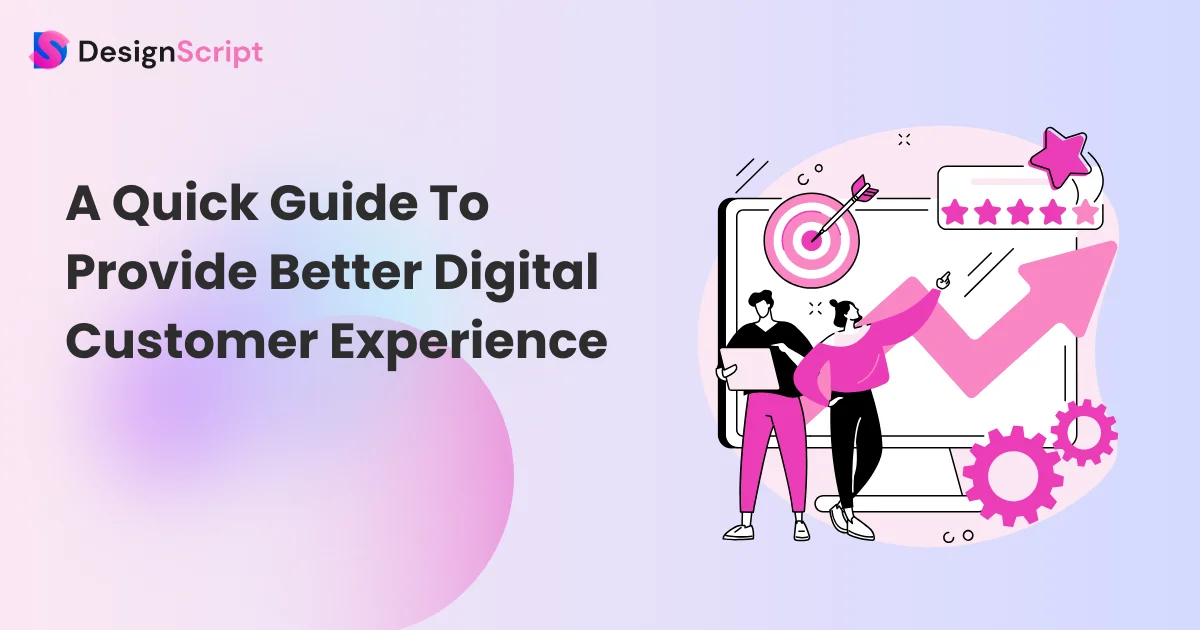A Quick Guide To Provide Better Digital Customer Experience
Did you know that a well-designed onboarding experience can increase your customer retention rates by a massive 50%?
Yes, this impressive fact shows how important a smooth customer onboarding process can be. However, the right process matters. If you are new to it, you may not know how to proceed which will not get you results.
But don’t worry!
In this blog post, discover how to turn new customers into loyal fans with strategies that not only grab your audience’s attention but also keep them engaged.
Dive into the world of improving digital customer experience and create a future where customer loyalty knows no limits.
Table of Contents
What Is Digital Customer Experience?
Digital customer experience refers to the interactions customers have with a company through digital channels like websites, mobile apps, online communities, email, social media, and more. It encompasses the entire journey a customer takes when engaging with a brand digitally.
It’s super important for businesses to make sure visitors have a good time online, just like when they visit a real store and feel happy about it. Websites and apps have to be easy to use, just like a store where everything’s in the right place and easy to find.
The people who run websites need to talk to customers instantly when they ask questions. They can do this through messages, emails, or social media to make sure customers are happy.
Making sure a website looks and works the same on all devices is really important so that everyone can use it easily. As a business owner, check how people use the site to make it better, offering what people like.
Keeping online payments safe is as important as the customer feeling safe while paying by cash in a store. Getting feedback from customers helps make the website better all the time, so people trust it more. All these things together make customers happy and want to keep coming back.
Why Are Digital Customer Experiences Important?

Digital customer experiences are crucial for businesses. Similar to a well-maintained physical store with friendly staff, a user-friendly website or app leaves a lasting positive impression.
When online platforms are intuitive and easy to navigate, customers feel valued and are more likely to stay engaged. Understanding customer behavior online helps businesses tailor their services to meet specific needs and preferences.
This personalized approach enhances customer satisfaction and fosters repeat purchases. Additionally, ensuring secure online transactions builds trust and confidence among customers, safeguarding their sensitive information. Ultimately, a positive online experience cultivates customer loyalty and generates positive word-of-mouth, which is essential for sustained business success.
How Does Digital Customer Experience Differ From Customer Experience?

Digital customer experience (DCX) refers specifically to customers’ interactions and perceptions of a brand through digital channels and touchpoints. In contrast, customer experience (CX) is a broader term that includes all experiences and touchpoints between customers and a brand, digital or otherwise.
Here are some key differences:
- DCX focuses on digital channels like websites, mobile apps, online ads, email, social media, chatbots, etc. CX includes offline/physical interactions like in-store, over the phone, mail, etc.
- DCX relies heavily on digital technologies like AR/VR, AI, big data, etc. CX may leverage some digital tech but also focuses on real-world human interactions.
- DCX aims to provide seamless omnichannel experiences across devices/platforms. CX looks to connect digital and offline channels.
- DCX emphasizes data/insights to optimize and personalize digital touchpoints. CX applies insights from all channels for a holistic view.
- DCX metrics include digital engagement, conversions, user journeys. CX metrics are broader, like customer satisfaction and lifetime value.
- DCX roles like UX designers and digital marketers are focused on digital. CX roles like CX managers span digital and physical.
Digital Customer Experience Best Practices
You can turn random visitors into happy, regular customers by following a few best practices. When customers are satisfied, it means they like your product or services, and that’s great for your business! So, using these tricks makes people love your online place and brings you more success.
1. Know your audience

Understanding your audience is like knowing your best friend’s favorite food. Just as you cook their favorite meal to make them happy, understanding your customers’ likes and dislikes helps create a website or app they’ll love. Imagine your website is a menu, and you arrange it with dishes your friends love. When customers find what they enjoy easily, like picking their favorite dish, they feel delighted and return for more. It’s all about making your online space cozy and familiar, just like a favorite restaurant, so visitors feel happy and satisfied every time they visit.
2. Track your customers’ journey

Picture strolling in a mall with your buddy, seeing what catches their eye and what they buy. Online, it’s just like that: you observe what visitors do on your websites. Knowing their path helps improve your site, fixing parts that confuse them and making it more straightforward. Imagine your websites as a fun store: you rearrange things so visitors quickly find what they want, just like organizing toys in a playroom. By understanding how people move around your site, you ensure they have a smooth and enjoyable experience, similar to having a great time shopping with a friend in a store.
3. Create an omnichannel customer experience

Think of your business like a storybook available in different stores. Omni-channel means having the same story across all platforms, whether your websites, social media, or apps. Like reading the same level in other places, customers get a consistent experience, making them feel comfortable wherever they find you.
4. Pay attention to mobile experiences

Many people use phones and other mobile devices to visit websites. Therefore, making your site easy to use on mobile devices is essential. This will ensure that your prospects have access to your site regardless of the device they use. When the site works smoothly, people enjoy their time.
5. Adopt analytics

Analytics are like having a magical map showing where everyone goes in your store. It tells you which sections are popular, how long people stay, and what they like. Knowing this helps you rearrange your store, putting popular items in front. On your websites, it means arranging content so people find what they want quickly.
6. Create a customer feedback loop

Imagine having a suggestion box where customers share what they like or don’t like in a store. Online, it’s similar; you ask customers for their thoughts. Listening to their feedback helps you understand their needs. It’s like having a conversation, making your store better based on what your customers say.
7. Conduct user testing

User testing is like asking your friends to play a game you made. You watch how they play, noticing what they understand and what confuses them. Similarly, you ask people to use your websites and see if they find it easy to navigate. Their experiences show what works and what needs fixing, helping you make your websites better.
8. Think like a futurist

Being a futurist is like being a fortune teller but for things people might like later. In the online world, it’s about guessing what customers could want. Imagine you’re a chef who invents new yummy recipes before anyone asks. Similarly, in the digital space, you plan and add cool features to your websites, like creating new toys before kids know they want them. By preparing for what might come, your website becomes like a surprise toy box, always full of exciting stuff, making visitors happy and eager to explore what you’ve prepared for them.
9. Always find ways to improve

Think of your websites as a garden that needs care and attention. Regularly checking your websites is like tending to your plants. You water them, remove weeds, and make the garden beautiful. Similarly, on your websites, you fix what’s not working, update content, and add new features. By constantly improving, your digital space becomes inviting, making visitors want to return.
Following these digital customer experience tips is like building a solid foundation for your online shop or websites. Imagine knowing your customers well, understanding what they like and don’t. It’s like being a good friend who listens and knows what makes others happy.
Digital Customer Experience Trends
Here is a straightforward overview of current digital customer experience trends in business:
1. AI Advancements

As a business, you can use artificial intelligence to improve customer experiences. Chatbots and virtual assistants that incorporate AI algorithms are becoming go-to tools for delivering swift, tailored customer service. Not only do they operate 24/7, but they can comprehend natural language and improve with experience. Overall, AI advancements empower companies to foster stronger customer relationships by providing the ultra-personalized, human-like digital experiences that today’s consumers demand. With AI, businesses can boost efficiency while making customers feel valued as individuals rather than data points.
2. Enhanced Self-Service Capabilities
To empower customers and lower costs, companies are enhancing their self-service options to enable independent issue resolution. This involves expanding FAQ knowledge bases with detailed troubleshooting guides and adding step-by-step instructional videos for common product issues.
Support portals now provide customized DIY tools like live chatbots to quickly answer questions, interactive diagrams to visually guide repairs, and account dashboards to manage preferences. Other self-service perks include virtual try-on apps, 3D visualization tools and free trial periods. By implementing these useful self-help resources, businesses allow customers to conveniently find information, troubleshoot problems, change settings and evaluate products on their own terms. The result is better customer experience.
3. Emphasis on Predictive Analytics

Predictive analytics involves gathering data on past behaviors and using AI algorithms to forecast each customer’s future needs and interests accurately. Businesses can then tailor offers, products, and messaging to serve customers better. The aim is to deliver more relevant, personalized experiences.
The approach helps offer hyper-personalized experiences before customers even ask. This powerful technology aims to boost relevance and convenience, strengthening customer satisfaction. With greater predictive insights, businesses can demonstrate an intricate understanding of customers and provide more customized interactions that exceed expectations.
4. Integration of Augmented Reality Tools
Augmented reality is revolutionizing the digital shopping experience as forward-thinking companies integrate immersive AR technologies. In clothing retail, for instance, augmented reality allows customers to virtually “try on” items at home. This way customers can better assess fit and style before purchasing. For makeup, AR apps let customers digitally test colors on their faces to find the perfect shades. Home goods retailers use AR to help customers visualize furniture in their actual living spaces. Overall, these interactive augmented reality features provide experiential digital shopping journeys that feel lifelike and personalized.
5. Focus on Data Security and Privacy

With growing cyber threats, companies prioritize protecting customer data and privacy. Security measures like encryption, two-factor authentication, and blockchain databases aim to build trust and peace of mind. Companies realize that failing to secure data properly can severely damage consumer trust and loyalty. By focusing on data protection and privacy, businesses can assure customers their information is in safe hands. This peace of mind leads to great customer experience & lasting relationships.
Brace for a future where online encounters are carefully crafted to cater specifically to your business needs!
Digital Customer Experience Examples
Let’s look at a few examples,
1. Warby Parker’s Virtual Try-On
Ever found it tricky to choose glasses in a store? Well, Warby Parker, those awesome glasses folks, have made it super simple online! They’ve got this cool tool that shows customers how glasses look on their face without leaving home. It’s like having a magical mirror on customers’ computer screens.
Customers just click, and voila! They can try on loads of glasses right there. No need to worry if they’ll look good – customers can see for themselves. It’s like playing dress-up but with glasses. So, they can have fun and find the perfect pair without stepping out!
2. Apple’s Omni-Channel Experience
Apple is like the superhero of easy shopping! Imagine this: customers want a new gadget, right? With Apple, there’s no need to wait for delivery. Customers order it online and then head to a nearby store to pick it up.
No long waits, no fuss. Customers get what they want, and they get it super fast. Apple connects its website with actual stores, making it as simple as grabbing a favorite snack. Quick, easy, and no hassle – just the way customers like it!
3. UNICEF’s Chatbot for Societal Change
UNICEF, those amazing helpers for kids, have a smart chat friend! It’s like talking to a friendly expert who makes complicated things easy. This clever chatbot shares stories and answers questions, just like a wise buddy explaining stuff.
Imagine having a friend who knows everything and can tell stories to help understand important issues. It’s like having a super-smart friend by customers’ side, helping them grasp what’s happening in the world without any confusion. Thanks to this fantastic chatbot, understanding important stuff is as simple as having a nice chat with a friend!
Offer An Outstanding Digital Customer Experience!
Staying ahead of digital customer experience trends takes work, but the payoff in customer satisfaction and loyalty is immense. By embracing AI advancements, self-service tools, predictive analytics, augmented reality, personalization and rigorous data security, you can provide the cutting-edge, tailored digital experiences that today’s consumers expect.
With vision and adaptability, you can continue improving and humanizing your digital offerings to connect with audiences in meaningful new ways.
Don’t forget to thank us when you win over customers!
FAQs
The best digital customer experience platforms include Hotjar, intercom, and Zendesk. These are magic tools that help businesses create friendly and easy-to-use websites and apps.
Some proven examples of top-notch digital customer experiences include user-friendly online stores like Amazon, where finding and buying products is effortless. Similarly, websites like Warby Parker allow customers to virtually try on glasses, ensuring a convenient and enjoyable shopping experience.
Digital customer experience metrics help companies to understand if people are finding what they need, if they are happy with the services, and if they are coming back for more. Enterprises use these metrics to ensure you enjoy exploring their websites and apps.

